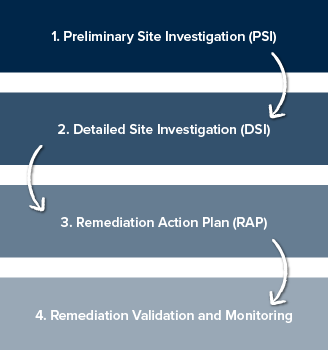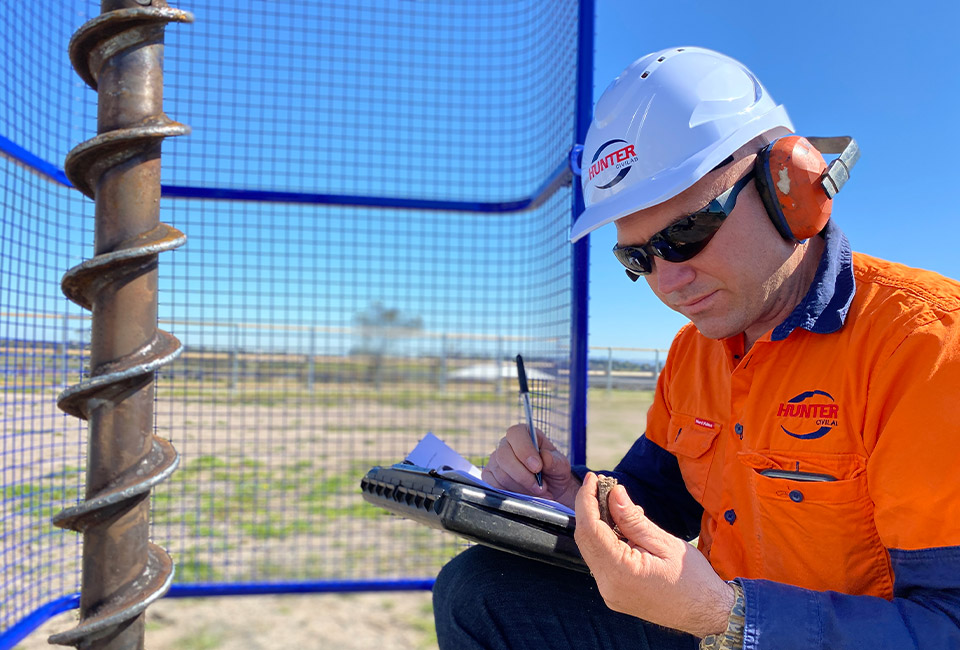Site investigations, remediation plans, validation and monitoring
Contaminated Land Management
Our Environmental Services team offer a range of specialist inspections, assessments, sampling, testing and reporting for the purpose of Development Applications and land use changes.
Contaminated Land Management refers to the various frameworks by which contaminated land is assessed and remediated such as under the NSW EPA Contaminated Land Act 1997, or by which sites are assessed as part of land-use change or Development Applications (DAs), specifically under State Environmental Planning Policy No. 55 (SEPP 55).
As part of a DA, planning authorities may request a site is formally assessed for contamination by a suitably qualified consultant which involves: a site investigation and assessment of any impacts on the natural environment, considering any legislative instruments and policies such as SEPPs, Local Environment Plans (LEPs), National Environment Protection Measures (NEPMs).
There are different levels, or phases, of investigation requirements depending on specific circumstances. One, some or all the below services may be required depending on proposed land use and government regulations.

Preliminary Site Investigations (PSI)
A Preliminary Site Investigation, also referred to as a Phase 1 investigation, is often the first step in determining the contamination status of a site.
A PSI involves a desktop study to collect and identify basic site information and characteristics, a site inspection, and the preparation of a report. Such an investigation should be sufficient to identify:
- Historical sources of contamination
- Potential contaminants of concern
- Areas of contamination
- Human and ecological receptors
- Affected media (e.g., soil, groundwater, surface water)
Limited sampling may be included in a PSI, provided sufficient information is available to compile an appropriate site health and safety plan.
In some instances, an Environmental Site Assessment (ESA) can substitute a PSI at lower cost to the client. Hunter Civilab can liaise directly with the relevant authority to determine whether an ESA is appropriate.

Detailed Site Investigations (DSI)
A Detailed Site Investigation, or Phase 2 investigation, is required when contamination is present or potentially present, and are generally required when a PSI has identified potential contamination or the regulator (e.g. Council) has reason to suspect contaminating activities may have occurred.
Potential or actual contamination will usually require further delineation via sampling to ascertain the lateral and vertical extent. As such, a more detailed sampling and testing regime is undertaken.
A DSI also sets out to identify the nature of any contamination so that an appropriate level of risk assessment can be undertaken.
The ultimate purpose of a DSI is to provide the basis for the development of an appropriate remediation or management strategy, should gross contamination be discovered.

Remediation Action Plan (RAP)
A Remediation Action Plan is a process undertaken to develop appropriate remediation strategies for a site. A DSI forms the basis for the required extent of remediation required, including the contaminants and receptors at risk from identified contamination.
A RAP may also be required if redundant dangerous good storage such as in-ground fuel tanks are present, even if contamination has not been identified.
A Remediation Plan will present multiple options for consideration based on specific circumstances. These can include the type and extent of contaminants; infrastructure constraints; cost-benefit; and environmental benefit, for different remedial strategies.

Site Remediation Validation and Monitoring
A Validation Assessment and Monitoring is conducted post-remediation to demonstrate whether contaminants have been removed and the objectives stated in the RAP have been achieved. Validation is an important prerequisite of a notice of completion and is a requirement of SEP 55.
Periodic monitoring of the site may be required when some contamination is left in-situ, often as a result of boundary and service remediation restraints.

Activities that may cause soil contamination:
- acid/alkali plant and formulation
- agricultural/horticultural activities
- airports
- asbestos production and disposal
- chemicals manufacture and formulation
- defence works
- drum re-conditioning works
- dry cleaning establishments
- electrical manufacturing (transformers)
- electroplating and heat treatment premises
- engine works
- explosives industry
- gas works
- iron and steel works
- landfill sites
- metal treatment
- mining and extractive industries
- oil production and storage
- paint formulation and manufacture
- pesticide manufacture and formulation
- power stations
- railway yards
- scrap yards
- service stations
- sheep and cattle dips
- smelting and refining
- tanning and associated trades
- waste storage and treatment
- wood preservation
Partner with us on your next project
Contact our specialised team for more information about our services.